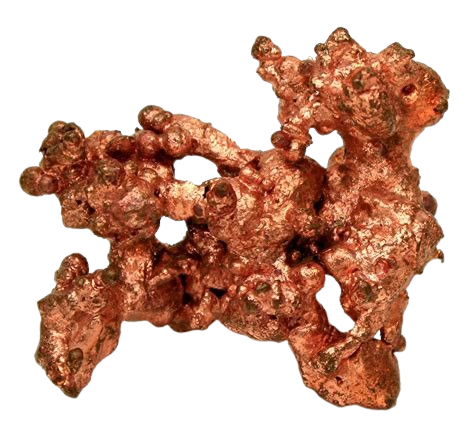🪨 Copper

Name: Copper
Type: mineral
Rock_type: igneous
Atomic_number: 29
Element_symbol: Cu
Origin_countries: Chile, Peru
Uses: electronics, infrastructure, renewable energy, wiring, plumbing
AKA: cobre
Origin & Location
The word copper is a corrupted form of a Latin word that meant “metal of Cyprus," referring to Roman copper mining on the island of Cyprus. The modern name for the element first came into use around 1530.
-
Primary source(s):
- Chile: Especially in the Atacama Desert region (e.g., Chuquicamata and Escondida mines)
- Peru: Southern highlands (e.g., Las Bambas, Cerro Verde)
-
Geological context:
Found in porphyry copper deposits, formed by hydrothermal fluids in igneous rock intrusions, particularly along tectonic plate boundaries of the Andes.
Uses
Uses may be industrial, cultural, nutritional, etc.
-
Used in:
- Wiring and cabling (electricity and telecom)
- Electric vehicle motors and wind turbines
- Plumbing, roofing, coins, and industrial machinery
-
Global demand drivers:
- Surge in green tech and electrification
- Construction in emerging markets
- Digital infrastructure (data centers, 5G)
-
Essential for human nutrition
🗺️ Story of Discovery & Exploitation
-
Initial discovery:
Indigenous peoples of South America, including the Moche and Inca, used native copper for tools and ornamentation as early as 500 BCE. -
Colonial/modern extraction:
Spanish colonizers initially focused on gold and silver, but copper became significant in the 19th and 20th centuries. During the 20th century, U.S. and British companies dominated Chile’s mines. -
Modern situation:
In 1971, Chile nationalized its copper mines (e.g., CODELCO), which remains state-owned, but foreign companies still dominate parts of the supply chain. Peru has seen violent conflicts over mining expansion on Indigenous land, particularly in the Andean highlands.
⛏️ Extraction Requirements
-
Mining method(s):
- Open-pit mining (Chuquicamata is one of the world’s largest)
- Underground mining (less common)
- Smelting and acid leaching (produces toxic waste)
-
Environmental cost:
- Massive water use in arid regions
- Acid mine drainage contaminates rivers
- Tailings ponds threaten ecosystems and communities
-
Human cost:
- Displacement of indigenous communities
- Labor exploitation and union crackdowns
- Heavy metal exposure for nearby residents and miners